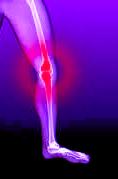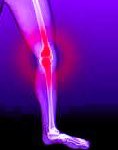This past week I hurt my knee, from working out without being sufficiently warmed up. Since I am usually flexible, energetic, and easily able to move and bend, having to make my way around more slowly than I’m used to was no fun at all.
I wanted this to heal as fast as possible, so became hyper-aware of what I was doing that caused pain. I could bend it pretty deeply, but not with weight on it. The heaviness of the thick quilt on my bed hurt in certain positions, as did the bony knee of the other leg poking it when I was on my side, unless I arranged myself just right when lying down.

I quickly found I couldn’t put up with the pain, “toughing it out”, and have it improve — I had to baby myself. As soon as it started to hurt from something I did, I stopped. Immediately. And it’s almost better! OK, what did I learn that I can apply to my vision?
This seems like an in-my-face lesson to remind me of all the vision improvement principles I already know so well, and am not as consistent in practicing as I could be. I’ve been aware for a while now that I’m so used to visually straining, it seems normal to me. This is not good! I’ve wanted to raise my awareness of visual strain, so I can keep letting it go, and am now using the knee situation to give me a “leg up” (ha ha!) with that. Be careful what you ask for!
In no particular order, here’s what my knee is teaching me about my vision.
1. If it hurts (I experience eyestrain or blur), it means I need to do something differently. Continuing what I’m doing is just reinforcing a bad habit.
2. Slow and gentle movement is a better choice than rushing.
3. When I can bend it farther (see more clearly) than I could the day before, it’s time to celebrate and be grateful, not necessarily to push myself harder right away.
4. Tricks like walking with most of my weight on the other leg (or visual tricks like squinting) are only a short-term solution, and will make something else hurt. Experimenting with a wide-legged stance caused my hip to complain. This reminded me of someone I know who had a “bum knee” for years from a high school football injury, and eventually got a knee replacement and a hip replacement! I wondered if favoring his knee for so long had negatively affected the hip. Note to self: don’t look for a short-cut! Keep your posture and body alignment straight. Use your easy natural vision.
5. Healing (increased clarity) happens at its own pace. I can support it with my habits, like taking extra vitamin C since it’s such a help in physical healing (and also concentrated in the lens of the eye, coincidentally). But I can’t force it, or I’m likely to set myself back.
6. A good attitude and optimism will carry me farther than grumbling. Plus I’ll be a nicer person to be around!
7. My knee (eyes) will tell me when it’s time to push and work out again. The analogy doesn’t hold perfectly here, since my vision exercises are more like play than a “workout”. Yet if my eyes are tired and feeling strain, I should be palming (or napping!), not forcing myself to look at the eye chart.
I’m hoping something here is helpful for you and your vision program, especially if you’re athletic. I mostly wrote it for myself, to capture what I’ve learned from this exerience so I can refer back to it later. It is not smart to keep making the same mistakes, and I want to do better in the future.
get help on our Facebook Group!

I wore strong glasses, then contact lenses, from age 5 into my 40s. While making many mistakes, eventually l learned how to improve the way I use my eyes and to see in a more relaxed, healthy manner. It is my pleasure to coach others to do the same. Visit me at https://NancyLNeff.com.

I find that working “around” my minor injuries is effective at helping them heal. Rest just doesn’t seem to do it for me. I try to keep working out, warming up for longer, find other exercises that don’t directly work the injured area,
and do everything except that which really seems to make the injury angry, to keep the blood flowing and align with the M.E.A.T. protocol that trainers use nowadays for injuries.
I guess in terms of vision it means not pushing through eyestrain, like you say, and doing something else instead. Heck, even palming I see as not a total rest but a shift in using vision a little differently, with visualization, instead of whatever task was leading to eyestrain, to keep it working and actually help it do the problem task more easily even though that isn’t what’s being directly addressed.
Yes. The take-aways for me were not to keep pushing as you say, and especially not to twist my body into some kind of unnatural posture trying to accomplish the old movement, to let myself heal first. Haste makes waste! All kinds of parallels to vision improvement.